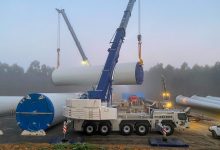Dr Alan Finkel, the former chief scientist and head of Australia’s National Hydrogen Strategy, says Australia still has a chance to get to the 82 per cent renewables energy target by 2030, but it needs to get everything right.
The 82 per cent target was modelled by the Australian Energy Market Operator in the central scenario of its landmark 30-year planning blueprint, the Integrated System Plan, and adopted by the federal Labor government as a target when it got voted into office last year.
It’s not a legislated target, and there is no particularly policy mechanism to get there, and there are increasing concerns that – because of delays in building transmission lines – it won’t be possible to reach it by 2030.
Finkel says it can still be done.
“If I was betting with dollars, I would say yes. If I was betting with my life, I’d be hesitant,” Finkel said in an interview for the latest episode of RenewEconomy’s popular and weekly Energy Insiders podcast.
“I think we’ve got a chance. But we have to get everything right,” he said.
“And you’ve probably been hearing a lot of reports from the (Australian Energy Week conference) this week, and people expressing their concern about transmission lines.
“And I deeply agree with that. The biggest challenge we’ve got at the moment is the rate that we can put our transmission lines. Without transmission lines, the new solar and wind farms from the renewable energy zones just can’t connect.”
Those comments sparked a lively debate between Finkel and Energy Insiders co-host and ITK principal David Leitch about the ability to build wind and solar farms before transmission is built.
Leitch argues that they can and that they should be. Others also point out that there is massive potential to “in fill” local networks – including with battery storage – to support wind and solar until the transmission projects can work their way through the complex regulatory and social licence hurdles.
This aspect, however, got little play in the Australian Energy Week conference, a favoured platform for hand-wringers and doubters, and where legacy energy giants can feel comfortable complaining how difficult the energy transition might be in order to justify their own slow progress.
Finkel, however, says Australia must, and can, aim high. He says the electrification process will require a trebling of Australia’s grid, just for domestic demand, and that’s before its massive potential to use its unique wind and solar resources to emerge as one of the few global “electro-states”.
A petro-state is an oil exporting state, and you might argue that it’s also a natural gas exporting state. But it’s a state that gets a substantial fraction of its revenue from exporting oil. And in the future, and we don’t know when – 15, 20 25, 30 years from now – the world will not be trading oil.
“But we still need to be trading energy and all the accoutrements around energy. So there are two opportunities to be an electro-state.
“One is trading energy.
“Australia, like some other countries, such as Chile, and Saudi Arabia, has the ability because of our abundant solar and wind resources and our project know-how to take renewable electricity in the form of solar and wind electricity, produce hydrogen and send that hydrogen or energy carrying derivatives of hydrogen such as ammonia around the world.
“In other words, we will be exporting sunshine, I call that shipping sunshine to other countries.
“Just because we get rid of oil, coal and gas doesn’t mean the countries don’t need to buy and sell energy, because not every country is endowed with what they need in terms of either hydro-electricity, solar or wind.
“So shipping sunshine is one way of being an electric state. The other is by exporting the resources, what I call the energy transition materials that will underpin the manufacturing economy for solar panels, wind turbines, batteries, electric cars, heat pumps, and the like.”
Finkel admits that shipping hydrogen is the expensive part of the equation, even if green hydrogen can be produced at competitive prices for the domestic market. Which he says it will be, even if the uses of green hydrogen may have diminished in recent years to a smaller number of key areas.
“Shipping sunshine, as hydrogen, will be expensive,” he says.
“But for countries like Japan, where they don’t have the (wind and solar) resources, they will need to import energy and importing it as much as hydrogen or ammonium or liquid organic hydrogen carriers will be important for them.
“But I don’t see shipping sunshine as extensive as the way we’ve been shipping … crude oil and natural gas and coal.”
See also: “Nothing can compete” Finkel concedes that battery electric beats hydrogen cars.










